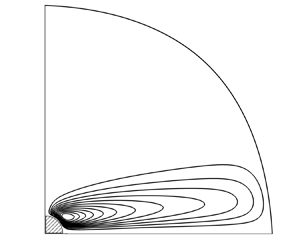No CrossRef data available.
Published online by Cambridge University Press: 23 December 2024

Convective flows near a cylindrical solid inclusion in a fluid-saturated porous medium heated from above are studied using the Darcy–Boussinesq equations. The impermeability condition is imposed on the inclusion surface. Two-dimensional convective flows uniform in the direction of the cylinder axis are considered. An Oseen-like approximation is implemented, however, different from the conventional Oseen approximation, quasilinearization is applied to the nonlinear terms in the energy equation and not in the momentum equation. It is shown that, when the thermal conductivity of the inclusion is higher than that of the fluid, the convective flow at a distance from the inclusion larger than the inclusion size takes the form of horizontal vortices directed away from the inclusion. In the case of low thermal conductivity of the inclusion, the direction of convective circulation is opposite: in the horizontal plane passing through the cylinder axis, the fluid is leaking to the inclusion.
To send this article to your Kindle, first ensure no-reply@cambridge.org is added to your Approved Personal Document E-mail List under your Personal Document Settings on the Manage Your Content and Devices page of your Amazon account. Then enter the ‘name’ part of your Kindle email address below. Find out more about sending to your Kindle. Find out more about saving to your Kindle.
Note you can select to save to either the @free.kindle.com or @kindle.com variations. ‘@free.kindle.com’ emails are free but can only be saved to your device when it is connected to wi-fi. ‘@kindle.com’ emails can be delivered even when you are not connected to wi-fi, but note that service fees apply.
Find out more about the Kindle Personal Document Service.
To save this article to your Dropbox account, please select one or more formats and confirm that you agree to abide by our usage policies. If this is the first time you used this feature, you will be asked to authorise Cambridge Core to connect with your Dropbox account. Find out more about saving content to Dropbox.
To save this article to your Google Drive account, please select one or more formats and confirm that you agree to abide by our usage policies. If this is the first time you used this feature, you will be asked to authorise Cambridge Core to connect with your Google Drive account. Find out more about saving content to Google Drive.